![]()
![]()
![]()
Use LEFT and RIGHT arrow keys to navigate between flashcards;
Use UP and DOWN arrow keys to flip the card;
H to show hint;
A reads text to speech;
57 Cards in this Set
- Front
- Back
|
Spinal nerves are considered to be mixed nerves, which means that? |
Contain both sensory and motor neurons. |
|
|
Light passes through the following structures in which order? (Eye) |
Cornea, aqueous humor, lens, vitreous humor. |
|
|
Neuroglia that are positioned between neurons and capillaries and play a role in the blood-brain barrier are called _______? |
Astrocytes. |
|
|
What is not found in the central nervous system (CNS)? |
Auxiliary nerve (This specific nerve is in the PNS). |
|
|
Three components of the adult sternum are the ______, ______, and ______. |
Manubrim, body, and xyphoid process. |
|
|
The larynx provides: |
An open airway, functions in voice production, and routes air and food into proper channels. |
|
|
A neuron that contains several dendrites and one axon is referred to as: |
Multipolar. |
|
|
Melatonin is secreted by the: |
Pineal gland (in the brain). |
|
|
Which is a agranular cell? |
Monocyte. |
|
|
The brain stem consists of the _____, ______, and ______. |
Mid brain, medulla, and pons. |
|
|
Which of the following is not found on the right lobes of the lung? |
Cardiac notch. |
|
|
Epicardium is: |
Part of the serous pericardium. |
|
|
Which of the following provides the greatest surface area for gas exchange? |
Alveoli. |
|
|
Which of the following is involved in blood clot formation? |
Platelets. |
|
|
Melatonin is secreted by the ______ gland. |
Pineal gland. |
|
|
The endometrium is the: |
Connective tissue surrounding an individual axon. |
|
|
Disorders of balance may follow trauma to which nerve? |
Vestibulocochlear. |
|
|
The branches of spinal nerves that form networks called "plexuses" are the ______. |
Ventral rami. |
|
|
The major nerve plexus to the upper limbs is the _______. |
Brachial plexus. |
|
|
The chromosomal number in a normal human sperm is ___. (#) |
23. |
|
|
Place the following in correct sequence from simplest to most complex. |
1) Atoms 2) Cells 3) Tissues 4) Organ 5) Organ Systems. |
|
|
Place the following components of the reflex arc in correct order: |
Receptor, sensory neuron, integration center, motor neuron, effector. |
|
|
The portion of the neuron that sends impulses to target cells is called the _______. |
Axon. |
|
|
In a strict sense, the posterior pituitary gland is not an endocrine gland because it: |
Does not synthesize hormones. |
|
|
Place the following in correct sequence from the formation of a drop of urine to it'd elimination of the body. |
Nephron, collecting duct, minor calyx, major calyx, ureter, urethra. |
|
|
The sphincter between the stomach and the duodenum is the __________. |
Pyloric sphincter. |
|
|
The distal portion of the small intestine is known as the ______. |
Ileum. |
|
|
This organ is a 'food chute' and has no digestive or absorptive functions. |
Esophagus. |
|
|
Which abdominal structure is located in the right hypochondriac region? |
Gallbladder. |
|
|
From the esophagus to the anal canal, the walls of the digestive tract are made of the same four basic layers ______, _______, _______, and _______. |
Submucosa, muscularis, externis, and serosa. |
|
|
Which of the following is not classified as a lymphoid organ? |
Liver. |
|
|
This type of sweat gland begins to function at puberty and plays a little role in temperature regulation: |
Apocrine gland. |
|
|
What is the purpose of the serous membranes? |
They reduce friction so that viscera move freely. |
|
|
In the thick skin of the palm, the layer of the epidermis directly under the stratum corneum is the stratum ______. |
Lucidum. |
|
|
Spermatogenesis takes place in the: |
Walls of the seminiferous tubules. |
|
|
The portion of the uterus that assumes an active role during labor is the ______. |
Myometrium. |
|
|
All of the following glands contribute to the volume of semen except : |
Spongy urethral. |
|
|
The portion of the female reproductive system that is homologous to the penis of the male is the ______. |
Clitoris. |
|
|
The glands of the female reproductive system homologous to the male's prostate gland are the: |
Paraurethral glands (Skene's glands). |
|
|
Which of the following contain the receptors for hearing? |
Cochlea. |
|
|
A frontal (coronal) section through the human body can: |
Pass through both ears. |
|
|
The chest is (1) _______ to the abdomen. The brain is (2) _______ to the skull. The umbilical region is (3) ________ to the lumbar region. |
(1) Superior (2) Deep (3) Anterior |
|
|
Which joint is correctly matched with the type of joint indicated? |
Knee - synovial. |
|
|
In humans, B lymphocytes originate in: |
The bone marrow. |
|
|
An elaborate network of membranes in skeletal muscle cells that functions in calcium storage is the: |
Sacroplastic reticulum. |
|
|
The _______ body cavity contains the brain. |
Dorsal. |
|
|
An example of a long bone is: |
A tibia. |
|
|
Of the following sections, the one which correctly identifies the sequence of the vertebra from superior to inferior is: |
Cervical, thoracic, lumar, sacrum, cocyx. |
|
|
The small channels through the bony matrix that connect lacunae are called: |
Canaliculi. |
|
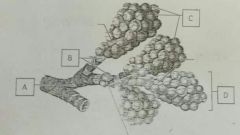
Name: |
A) Bronchi B) Bronchiole C) Aveoli D) Alveol. |
|
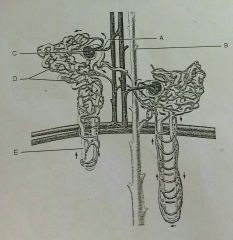
Name: |
A) B) C) Glomerulus D) Pertibular Capillaries E) |
|

Name: |
A) Larynx B) Trachea C) Xyphoid Process D) Diaphragm. |
|
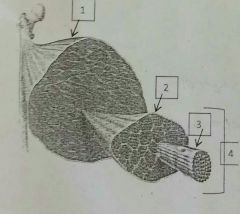
Name: |
1) 2) Perimysium 3) Endomysium 4) Fascicle |
|

Name: |
1) Sacromere 2) I Bond 3) A Bond (Whole thing is Z Disc) |
|
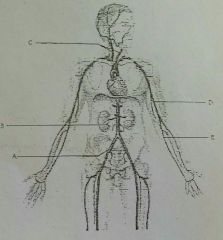
Name: |
A) Common Iliac Artery B) Renal C) D) Brachial E) |
|
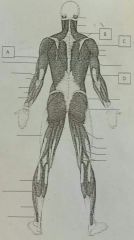
Name: |
A) Biceps Brachii B) Trapezius C) Deltoid D) Latissimus Dorsi. |
|
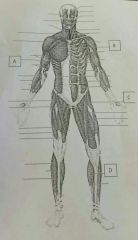
Name: |
A) Biceps Brachii B) Pectoralis Major C) Transversus Abdominus D) Gastrocnemius |

